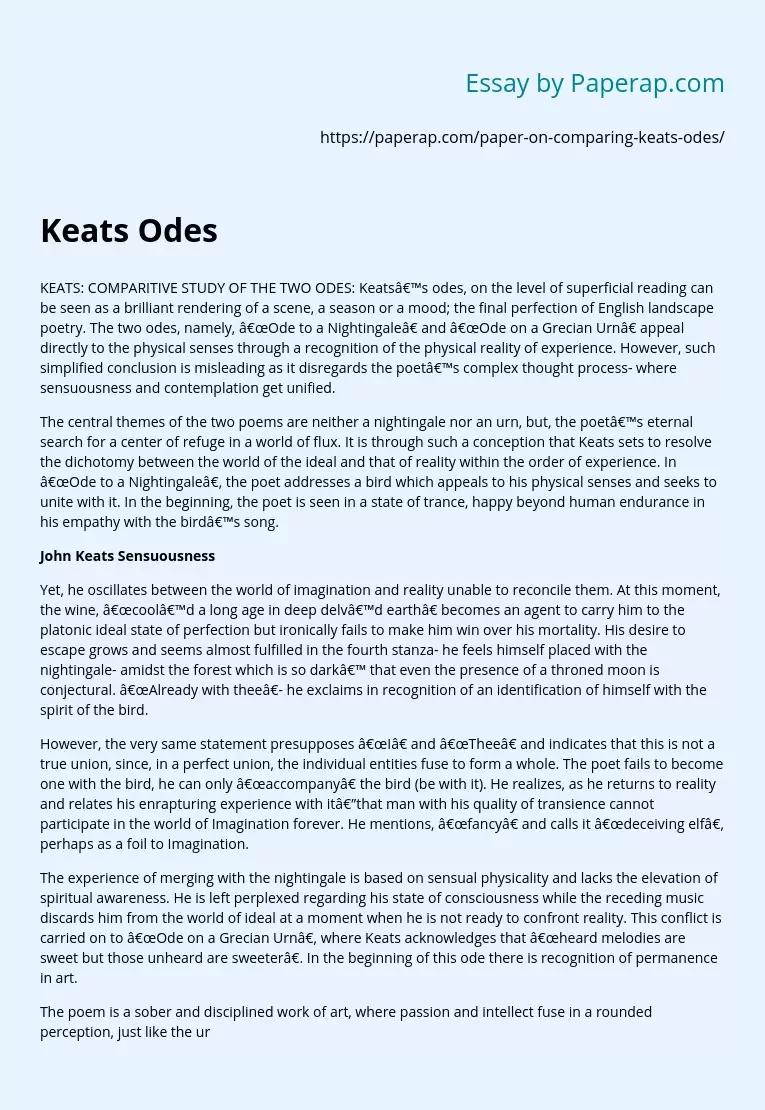Keats's Comparative Odes
KEATS: COMPARITIVE STUDY OF THE TWO ODES: Keats’s odes, on the level of superficial reading can be seen as a brilliant rendering of a scene, a season or a mood; the final perfection of English landscape poetry. The two odes, namely, “Ode to a Nightingale” and “Ode on a Grecian Urn” appeal directly to the physical senses through a recognition of the physical reality of experience. However, such simplified conclusion is misleading as it disregards the poet’s complex thought process- where sensuousness and contemplation get unified.
The central themes of the two poems are neither a nightingale nor an urn, but, the poet’s eternal search for a center of refuge in a world of flux. It is through such a conception that Keats sets to resolve the dichotomy between the world of the ideal and that of reality within the order of experience. In “Ode to a Nightingale”, the poet addresses a bird which appeals to his physical senses and seeks to unite with it.
In the beginning, the poet is seen in a state of trance, happy beyond human endurance in his empathy with the bird’s song.
John Keats Sensuousness
Yet, he oscillates between the world of imagination and reality unable to reconcile them. At this moment, the wine, “cool’d a long age in deep delv’d earth” becomes an agent to carry him to the platonic ideal state of perfection but ironically fails to make him win over his mortality. His desire to escape grows and seems almost fulfilled in the fourth stanza- he feels himself placed with the nightingale- amidst the forest which is so dark’ that even the presence of a throned moon is conjectural.
“Already with thee”- he exclaims in recognition of an identification of himself with the spirit of the bird.
However, the very same statement presupposes “I” and “Thee” and indicates that this is not a true union, since, in a perfect union, the individual entities fuse to form a whole. The poet fails to become one with the bird, he can only “accompany” the bird (be with it). He realizes, as he returns to reality and relates his enrapturing experience with it—that man with his quality of transience cannot participate in the world of Imagination forever. He mentions, “fancy” and calls it “deceiving elf”, perhaps as a foil to Imagination.
The experience of merging with the nightingale is based on sensual physicality and lacks the elevation of spiritual awareness. He is left perplexed regarding his state of consciousness while the receding music discards him from the world of ideal at a moment when he is not ready to confront reality. This conflict is carried on to “Ode on a Grecian Urn”, where Keats acknowledges that “heard melodies are sweet but those unheard are sweeter”. In the beginning of this ode there is recognition of permanence in art.
The poem is a sober and disciplined work of art, where passion and intellect fuse in a rounded perception, just like the urn which it talks about. He uses a series of imagery inspired by the carvings on the urn. Interestingly, he reflects on the presence of “absence”- the music unheard, the empty streets waiting for the people to return, the unfelt communion of the lovers who never unite. Thus, despite recognizing the superiority of Imagination over reality, he is troubled by the “cold pastoral” lifelessness of the moment frozen on the urn.
In both the odes, Douglas Bush observes, “… is a belief that whereas the momentary experience of beauty is fleeting, the embodiment of that moment in art, in song or in marble… is an imperishable source of joy. ” However, this embodiment is not infused with life. The beauty of the maiden is eternally true, but equally true is the lack of satiation of the lovers. Keats’ sensuousness reaches a greater level of perfection through this recognition of absence. Therefore, one might feel that it is easy to bring all the senses in ones poetry.
However, as far as Keats is concerned it is not just how he mentions various sensations of sight, sound, touch, taste and smell—it is about the flowers that he “can not see”, the music that he can not hear, the mystery that he can not unravel. His negative capability does not remain just a means to achieve objective distance from his own self, by negating himself to experience the world from a different viewpoint, but also to attempt to understand these sensations that even the inhabitants of that “different” point cannot experience.
This conflict between the present sensation and “absence”, fancy and imagination, transience and permanence is finally resolved in “To Autumn”. In this poem Keats understands that true fulfillment does not come from permanence but from maturation: “Ripeness is all”. However as he pens down the first two odes, this recognition does not dawn on him. He is still unable to solve the riddle of reality but his sensuousness makes him understand the disparity between the ideal and real and his contemplation makes him all the more eager to solve the riddle.
Keats's Comparative Odes. (2019, Dec 05). Retrieved from https://paperap.com/paper-on-comparing-keats-odes/

